Father of Modern Art: Paul Cézanne
January 19th marks the birthday of one of the prominent French artists of Post-Impressionism – Paul Cézanne. He is often regarded as the father of...
Valeria Kumekina 5 June 2024
When Georges Seurat developed Pointillism – painting with little dots – in the mid-1880s, it seemed like a pretty niche idea. Yet for the next thirty years, artists as diverse as Van Gogh, Matisse, and Mondrian experimented with his technique. What is Pointillism and why is it a great technique for landscapes?
Divisionism, Neo-Impressionism, Chromo-luminarism: there are lots of names for this short-lived but influential movement. However, as often happens, it was the critics’ negative description, Pointillism, which stuck. In 1886 Georges Seurat (1859-1891) exhibited his most famous work, Sunday Afternoon on the Ile de la Grande Jatte, at the last Impressionist exhibition. This huge canvas was a kind of manifesto of Pointillism, painted with small dots of color and a strong emphasis on line. Furthermore, it took an Impressionist subject, Parisians at leisure, and turned it into something very different.
By applying pure colors to his canvases in small regular dots, Seurat wanted the viewer’s eye to mix the paint, creating a more immediate and intense experience. Up close, pointillist grass is a muddle of yellow and blue spots but from a distance, it becomes shades of green. Like the Impressionists, Seurat also used Michel Chevreul’s color theory, putting complementary tones together to add vibrancy. However, he was interested in the formal qualities of his work as well. Simplified, stylized lines and painted frames emphasized that these were carefully constructed paintings, not just random views of nature.
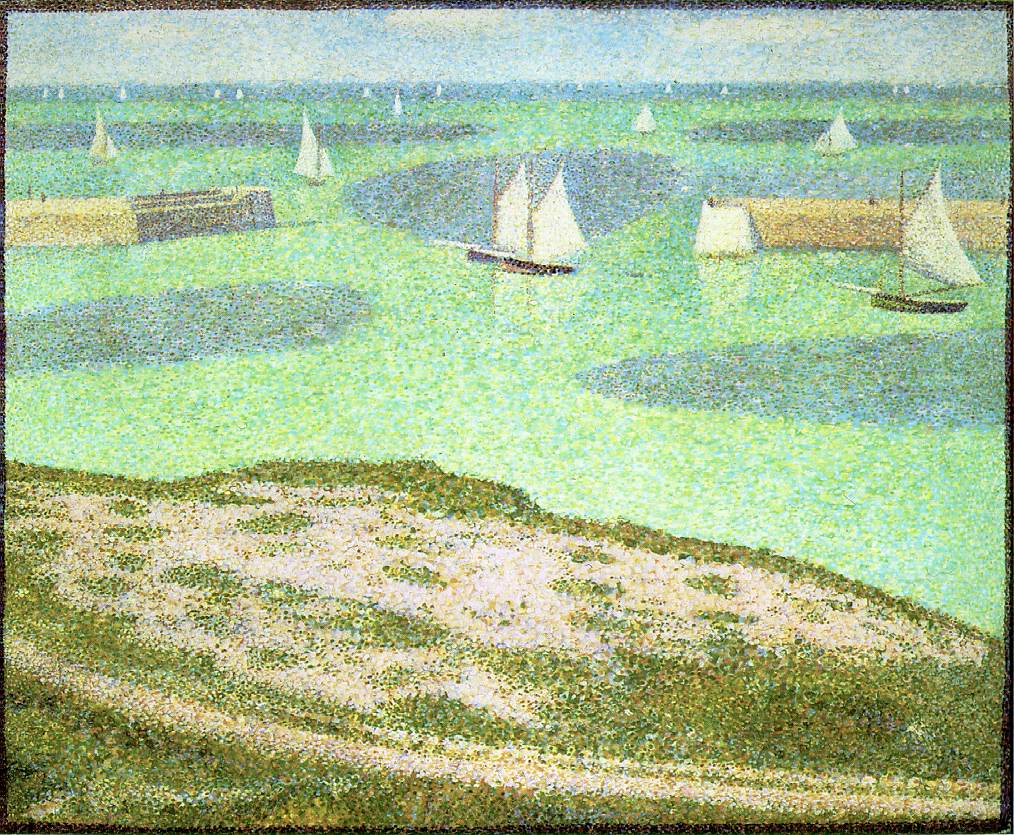
Georges Seurat, Port-en-Bessin Entrance to the Harbor, 1888, Museum of Modern Art, New York, NY, USA.
In 1888, Seurat spent time in Normandy, which was another Impressionist stomping ground. There he painted views of the sea and coastline. The pointillist technique in Port-en-Bessin turns a conventional view of a harbor into something static and slightly unworldly. This is not a snapshot of nature, showing wind, weather, and light, but a frozen, dream-like reinterpretation of the scene. The subtle tonal shifts in the sea and sky exemplify his use of pointillist “mixing”. Meanwhile the flattened perspective emphasizes his idea that line is also important in generating a response from the viewer. The whole scene is surrounded by a painted frame, created with pointillist dots.
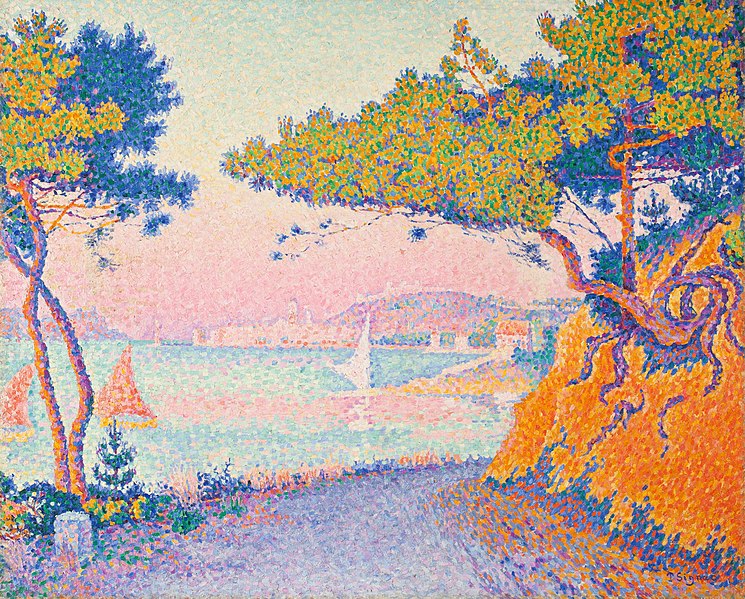
Paul Signac, Golfe Juan, 1896, Worcester Art Museum, Massachusetts, MA, USA.
After Seurat’s early death in 1891, it was left to Paul Signac (1863-1935) to carry the flag for Pointillism. He was even more interested in the symbolic and emotional properties of art. Like James McNeill Whistler, Signac often included musical terms in the titles of his works to suggest that the subject was less important than the mood. After visiting the South of France and buying a boat in 1892, he painted a series of richly colored, lyrical landscapes and seascapes. The arabesque curves of the trees here are like the Japanese prints which were so popular at the time. Together with the strong foreground colors, they act to flatten the picture plane so that the landscape becomes almost an Art Nouveau design.
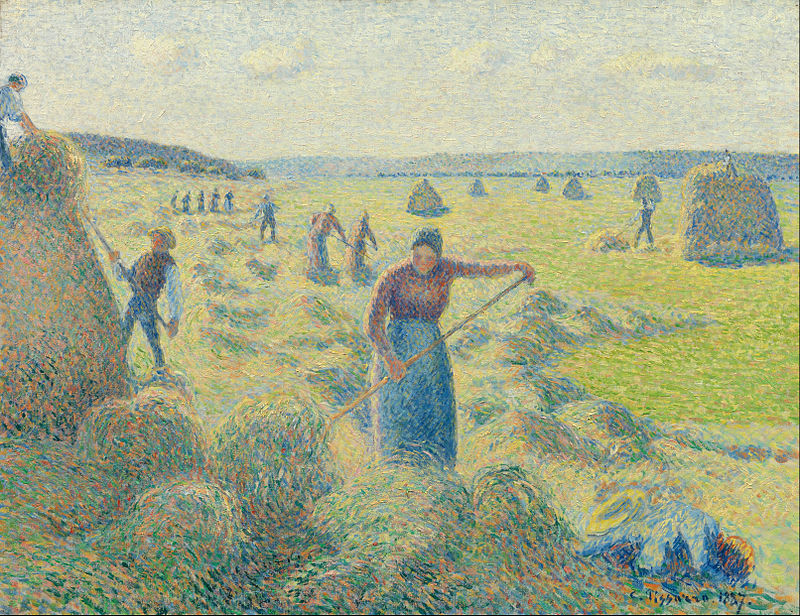
Camille Pissarro, Hay-Making, Eragny, 1887, Van Gogh Museum, Amsterdam, Netherlands.
Camille Pissarro (1830-1903) was an integral part of the Impressionist circle during the 1870s. However he experimented with Pointillism after being introduced to Seurat by his son. During the mid-1880s, he focused on images of agricultural life, like Hay-Making, painted around his home in Eragny. He was a committed socialist who wanted to educate his urban viewers about the lives of the rural poor. Pointillism gave a sense of permanence to his strong, monumentalized images of peasant workers. Pissarro eventually found Pointillism too restrictive and time-consuming and thus returned to a freer Impressionist style.
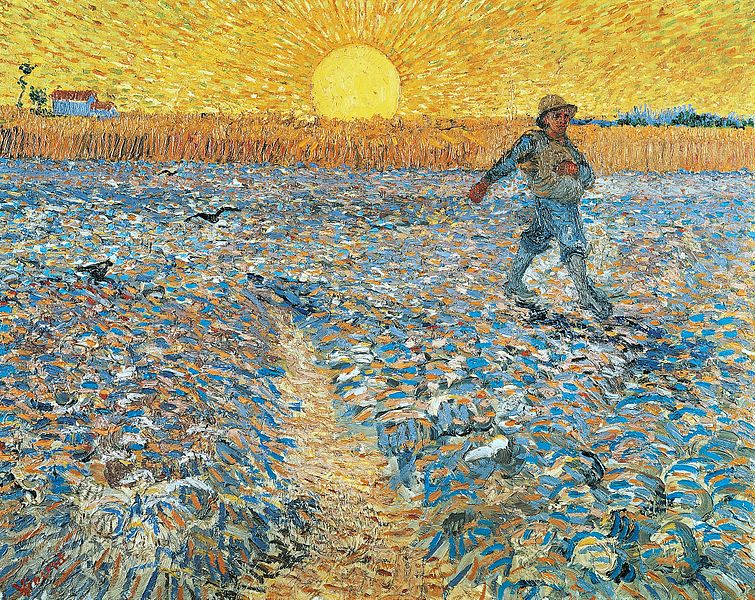
Vincent van Gogh, The Sower at Sunset, 1888, Kroller-Muller Museum, Otterlo, Netherlands.
Pissarro and Signac inspired Vincent van Gogh (1853-1890), who took the static dots of Pointillism and turned them into short, thick dashes of paint. The dash created an instance vibrancy that was lacking in conventional pointillist work, especially when applied with the heavy impasto which Van Gogh favored. He used the technique most obviously in his self-portraits, but it is apparent in landscapes like The Sower at Sunset as well. Ultimately, Van Gogh also found pointillism too restrictive: his brush marks became larger, more varied, and expressive.
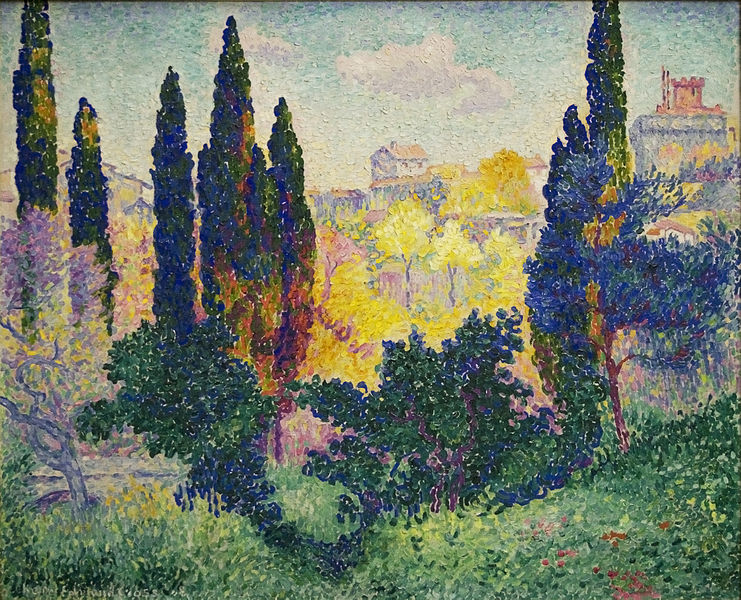
Henri-Edmond Cross, Les Cyprès à Cagnes, 1908, Musée d’Orsay, Paris, France.
Henri-Edmond Cross (1856-1910) was a significant exponent of Pointillism at the turn of the century in Paris. A close friend of Signac, he too lived in the south of France, where his home became a center for artists like Matisse and Derain. He developed a mosaic style by enlarging his ‘dots’ to small square brushstrokes, and often leaving patches of bare canvas between. The resulting image is more fragmented and impressionistic, with a greater sense of movement and naturalism.
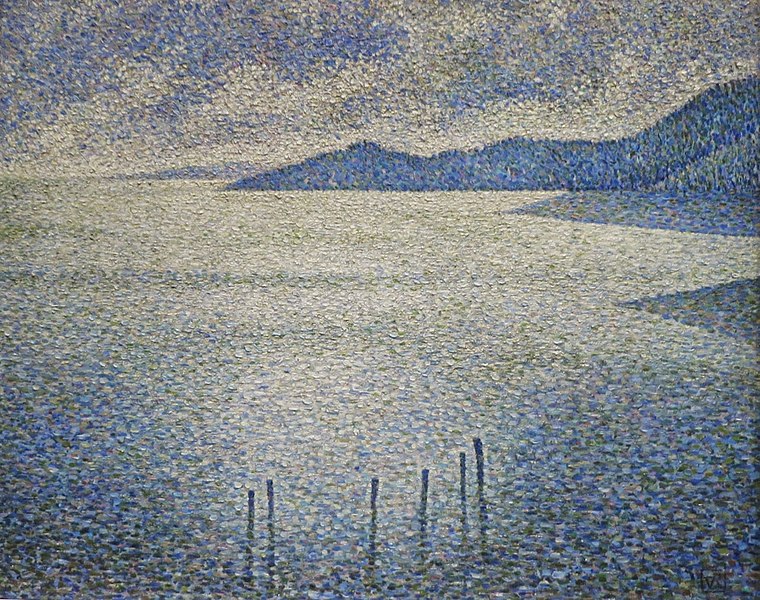
Theo Van Rysselberghe, Coastal Scene, 1891-3, National Gallery, London, UK.
Theo van Rysselberghe (1862-1926) is the most famous of the group of artists who popularized Pointillism in Belgium in the last years of the nineteenth century. Sunday Afternoon on the Ile de la Grande Jatte was exhibited in Brussels in 1887 and kick-started interest in the style there. Rysselberghe emulates Seurat in his use of subtle color and clean lines and, unlike many other French artists, he tends towards a cool palette of blues, greens, and pinks.
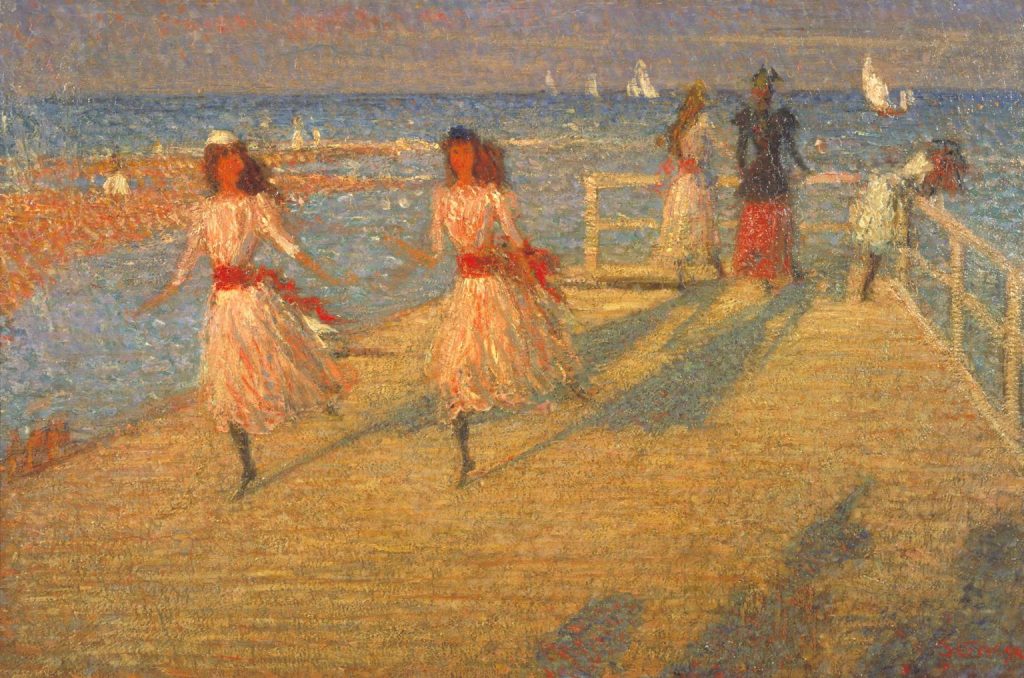
Philip Wilson Steer, Girls Running, Walberswick Pier, 1888-94, Tate Gallery, London, UK.
Wilson Philip Steer (1860-1942) created a series of pointillist-influenced landscapes in the 1890s while he was living and working on the East coast of England at Walberswick. These retain an Impressionist sense of freedom and movement, created by Steer’s use of random brushstrokes, but are clearly influenced by Seurat in his juxtaposition of colors.
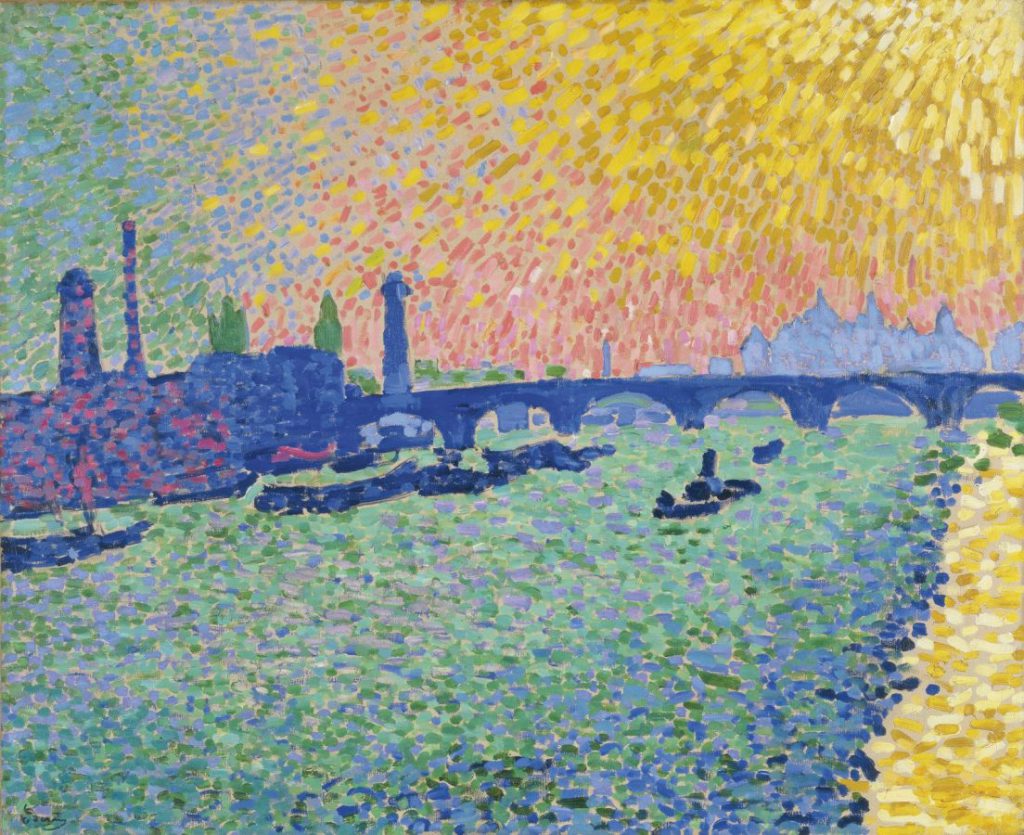
André Derain, Waterloo Bridge, 1906, Museo Nacional Thyssen-Bornemisza, Madrid, Spain.
Although Pointillism seemed to burn itself out pretty quickly, by the early 1900s Henri Matisse (1869-1954) and André Derain (1880-1954) were both using dabs of paint in their richly colored Fauvist landscapes. In 1906 Derain painted 30 canvases on a visit to London, including Waterloo Bridge. Derain described colors as ‘charges of dynamite’ and his pointillist technique lets them explode across the picture surface here.
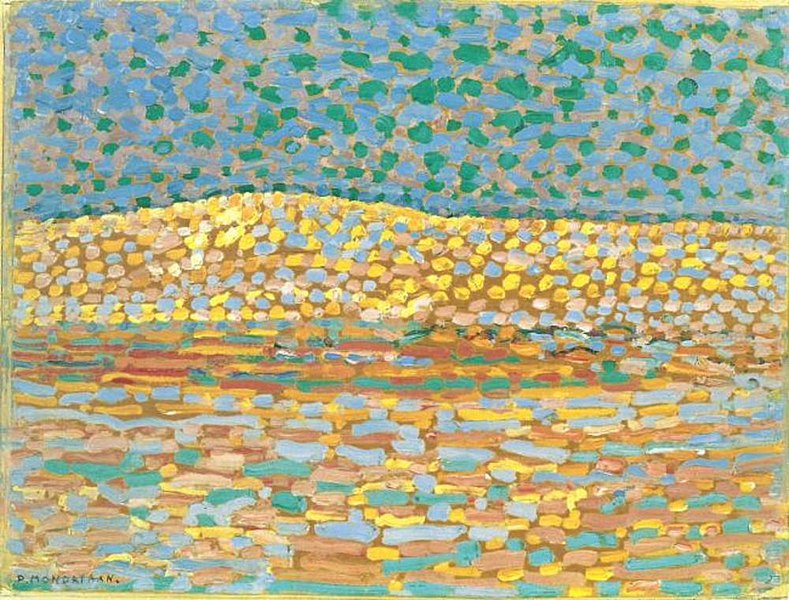
Piet Mondrian, Pointillist Dune Study, 1909, Artizon Museum, Tokyo, Japan.
Although Piet Mondrian (1872-1944) is most associated with geometric abstraction, he spent the years up to 1912 using landscape to experiment with color, brushwork, and geometry. In Dune Study, the simplified line, large dots and mixing of colors all show his knowledge of Pointillism. However, the beach scene has been pared down so much it is almost abstract.
Mondrian’s work took Pointillism almost as far as it could go. Later artists continued to be interested in the idea of mixing dots of paint on canvas though. Pointillism was definitely not just a dotty idea!
DailyArt Magazine needs your support. Every contribution, however big or small, is very valuable for our future. Thanks to it, we will be able to sustain and grow the Magazine. Thank you for your help!